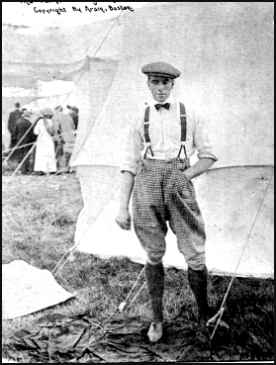
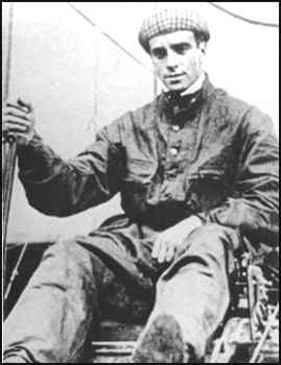
 |
 |
Collection of Dave Lam, 9-9-07 |
Photo Courtesy of Staffordshire Past-Track |
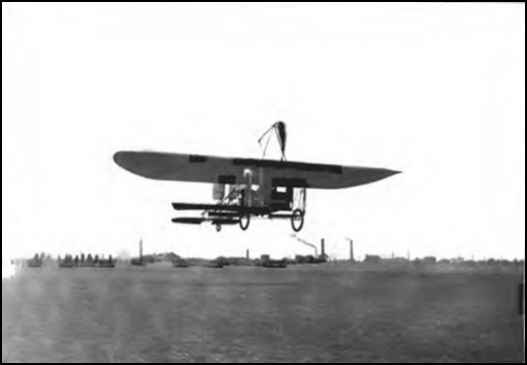 |
|
Cotributed by Doug Killick, 6-2-11 |
by Henry Serrano Villard The Model XII, however, had only a brief career. A miscalculation on landing one day, with Bleriot himself at the controls, resulted in the two-seated monoplane being wrecked; it was the last of its kind. Grahame-White returned to London and began the development of a great flying center at Hendon, on what was then a vacant, weed-covered lot. At the same time he entered the Henry Farman school at Chalons, learning to fly the biplane with which he would become famous for a dramatic dash in the dark of the night, racing Louis Paulhan for a 10,000 pound prize offered by the Daily Mail. The course from London to Manchester --- a distance of 183 miles --- had to be covered within 24 hours. Editors Note: I was privileged to know Henry during several years before his death. He was an fascinating companion and a lifetime friend of aviation. For many other interesting episodes in the life of Grahame-White, and for the complete story of the Gordon Bennett Race, I invite you to read Henry's book. |
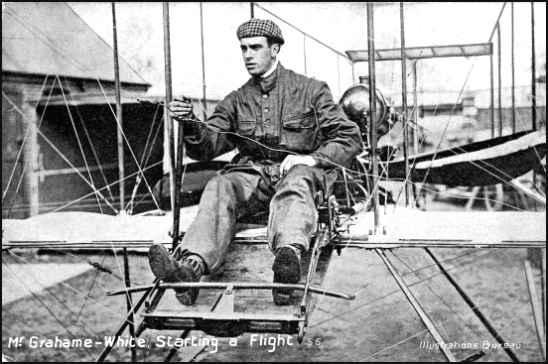 |
Collection of Dave Lam, 8-3-07 |
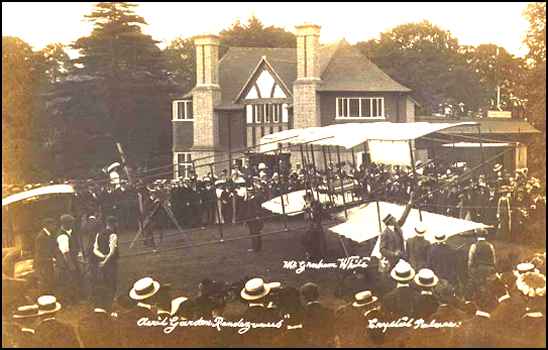 |
|
"Cleril Garden Rendezvous" Published by J. RUSSELL & SONS Crystal Palace July 18, 1910 |
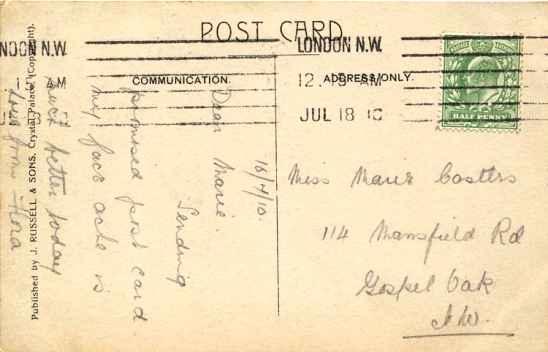 |
|
Collection of Len Worker, 2-25-04 |
|
via email from Colin Pomeroy, Sqn Ldr RAF (Ret). 3-11-04 I have just visited your website seeking, not information of Grahame-White, but on an aircraft photograph which I have just been loaned (see below). At the foot of your website you made a request for any information on the great aviator to be sent to you; this is an abbreviated version (missing out the obvious [Daily Mail race, etc]) on what I have uncovered about him down here in Dorset: "In May 1912 Claude Grahame-White and Benny Hucks came to Weymouth to participate in the review of the Home Fleet in Weymouth Bay. Grahame-White brought his Henri-Farman monoplane to the resort by rail, but the arrival method of his companion is not recorded. "G-W's" diminutive aircraft was later wheeled on its own purpose-built trolley along The Esplanade and Preston Road to 'The Weymouth Cricket Club's ground at Overcombe Corner', where it was re-rigged for flight. Overcombe Corner was, by now, also becoming known as the location of the Lodmoor airstrip! The Home Fleet was reviewed in Weymouth Bay by King George V - with HMS Hibernia and HMS Africa both present as ships within the 3rd Battle Group, and sporting their aviation ramps - and a contemporary souvenir wall chart of the review shows the two aircraft over the lines of warships. Most interestingly, the chart also marks the Cricket Club Airstrip - annotating it as 'LODMOOR. Aviation Ground and Hangars'. After the review Grahame-White left the local area with his aircraft by rail, but Hucks flew direct to London. He took off at 3.20 pm and arrived at Hendon at 5.51pm, giving him an average airspeed over the 142 mile route of just over 90 mph - a very creditable performance for the year 1912. As mentioned, HMS Hibernia was present for the review; however, a planned demonstration of her flying-off abilities for the sovereign was not carried out. Nevertheless Samson, Jerrard and Longmore all gave flying displays over the assembled warships - as did Grahame-White and Hucks. Operating out of Lodmoor and supported by personnel from Eastchurch in Kent, at that time effectively the centre of British naval aviation, these were probably amongst the most significant and formative flights carried out by RN pilots prior to The Great War of 1914 - 1918. So fascinated were the local folk by all this aerial activity, a strong police presence was drafted into Lodmoor for crowd control purposes." Regards, Colin Pomeroy, Sqn Ldr RAF (Ret). |
 |
|
at the Weymouth Naval Review, 6th May, 1912. Identification by "Jerry," Fleet Air Arm Museum |
 |
|
at the 1910 Boston Aero Meet. |
|
Daily Journal and Tribune, Knoxville, Tennessee: August 19, 1910, Via email from Bob Davis - 9-2-03 |
|
Walter Brookins Arthur Johnson Glenn H. Curtiss Charles F. Willard M. Didier Masson A.V. Roe, J. Graham White William M. Hilliard J. M. All_as Ernest P. Lincoln, Clifford D. Harmon Captain Thomas Baldwin Jacques Delesseps Dr. W. P. Christmas, John G. Stratton Horace F. Kearner Greely S. Curtiss |
Wright biplanes Wright biplanes Curtiss biplanes Curtiss biplanes Vendome aeroplane Roe Triplane Farman biplane & Bleriot monoplane; Herring-Burgess biplane Harvard biplane; Christmas biplane Burgess-Curtiss aeroplane Pfitzer monoplane Bleriot monoplane |
Some odd facts via email from Doug Killick, 8-30-05 On his trip to America he won a prize of $22,500 at a race in Boston. After his demonstration flight and landing in front of the White House he then gave "society ladies" flights charging $ 100 per minute. The flights normally took five minutes. An airplane race at Belmont Park, New York, netted Claude another $5000. This brought his income from his American visit to $250,000. On the eighteenth of October 1910 Claude took up a loaned Box kite he crashed and broke his left leg and ankle. Hospital not known but in the South of England somewhere. On the 9th May 1914? The first parachute drop from an aircraft was made. Claude piloting his "charabanc" with William Newall, the veteran parachutist, hanging on to one of the skids. At 2000 feet he let go and in 2 ½ minutes landed safely. Prior to that it was considered "ungentlemanly" to jump from an aircraft Richard Gates was killed six days later in an accident. W. L. Brock, from Bloomington, Illinois, was an instructor at Claude Graham-White's flying school during 1912. He became one of the most successful American flyers with his 80hp Morane-Saulnier. He was a noted misery and lacked charm. Claude first flew on 6th Nov 19?? Never having had a lesson! |
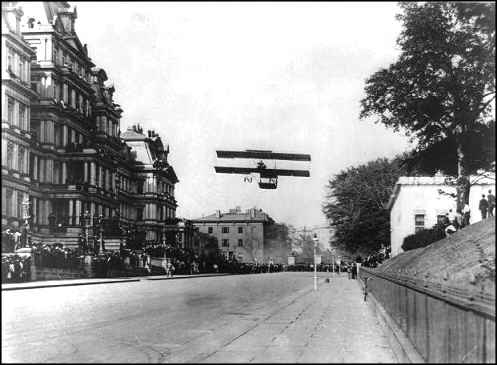 |
|
Flying between the Old Executive Office Building on the left and the White House on the right, 10/14/1910 |
|
via email from Doug Killick, 11-25-09 Question: Do you think the a/c would have been the one used for his "Waterplane tour" or would he have had a Curtis H4 Flying boat? ( I believe these did not appear until later, 1914ish) Any ideas of what it might be? CLAUDE GRAHAM-WHITE This information was extracted from a copy of the Essex County Chronicle (Date unknown, possibly June/July 1912) In the summer of 1912, Claude and his wife, Dorothy, were houseguests of Sir Daniel Gooch and Lady Gooch at Hylands House,Chelmsford, Essex. Claude and his wife went to Southend on Sea and from there flew to Clacton on Sea in his hydroplane. On the return journey to Southend, the aeroplane encountered problems to relate Claude's account. "We were about 3 miles out from the coast when the engine started misfiring and 3 inlet valves broke. This caused a fearful explosion and it backfired into the carburettor, which flooded, and the fuel caught fire." It was only a matter of seconds before the petrol tank would have ignited; the result would have wrecked the aeroplane. Claude leaned over his wife to turn the petrol off and put out the fire, burning his hand badly in doing so. Then Claude had the hazardous task of descending without the engine, but by skilful planing, the rapid descent was made and the hydroplane skimmed along the surface. It was now pitch dark and raining heavily and they were now drifting some 5 miles from the coast. A passing fishing boat offered them a tow to the coast but wanted a payment of £6 in cash before doing so! Claude refused to pay but requested they loan him an anchor. The fishermen refused. Help came by way of a passing yacht who took them to dry land, the hydroplane being recovered the next day. Meanwhile Sir Daniel and his guests, realising Claude was missing, notified the Admiral at Sheerness dockyard for a RN Destroyer to be sent to search. This was cancelled after news of their safe landing was notified. Can anyone suggest the make of his hydroplane? Was it the aircraft used in the Daily Mail Waterplane tour. Was it a Sopwith or possibly one of the first Short Bros? Editor's Note: If you can help Doug with the identification of this plane, please
contact me.> |
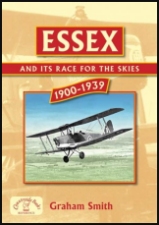 |
Essex and its Race for the Skies by Graham Smith Product Details A5 (soft cover): 224 pages Cover price: £10.99 Publisher: Countryside Books ISBN: 978 1 84674 054 1 |
|
Description from the
Countryside Books website: As recommended by Doug Killick, 10-13-07 "Essex was at the forefront of the pioneering days of flying. As early as May 1785 the first hot-air balloon had landed in the county and by the 1850s they had become a familiar sight. At the outbreak of the First World War in August 1914 six landing grounds were established with a seaplane station at Clacton. A year later Sutton's Farm (later to be re named Hornchurch) and Goldhanger were added to the list and two more were opened in 1916 at North Weald Bassett and Stow Maries. The target was initially Zeppelins and later German Gotha bombers. In peacetime, the county soon played host to flying circuses and air displays. Joy-riding became a favourite pastime. One local entrepreneur, Edward Hillman, was not slow to see the opportunities in air travel and basing himself at Maylands first opened up a route to the seaside resorts of Kent next to Liverpool, Glasgow and Belfast and then to France and Belgium. But another war loomed and by the mid 1930s seven new fighter stations were established; one of them RAF Debden. At the outbreak of the Second World War the nine fighter squadrons then based in the county were ready and eager to meet the Luftwaffe and open another heroic chapter in the aviation history of Essex. Illustrated." which can be accessed by clicking on the name. |
|
A very happy New Year to you and yours may you have peace and happiness throughout 2011. A quick update on the airfield. As you may remember this airfield, probably the best surviving of the period, is being restored. The owner and a band of helpers have done wonders and the task is nearing completion. The original buildings have been restored and signed, Staff in replica uniforms and the latest is that 3 original aircraft may be based there. It is now open to the public on a regular basis and, I'm pleased to say, without a profit motive! I will give you a further update during the summer months when flying returns to RFC 39HD Squadron base. Take care Doug Killick |
|
Courtesy of Giovanni Giorgetti, 7-28-11 Italian GRAHAME-WHITE CLAUDIO. - Nato a Southampton il 28 agosto 1887, conseguì il brevetto di pilota aviatore il 4 gennaio 1910 su Bleriot (brevetto N. 30). Tentò per primo il raid Londra - Manchester, ma un guasto gli fece perdere il premio di 25000 lire che venne vinto invece da Paulhan. Nell’agosto del 1930 compì una serie di voli notevoli, e nel settembre dello stesso anno si distinse al meeting di Boston. Fu il vincitore della seconda Gordon Bennet (V.) avendo coperto i 100 km. in ore 1,1’4’’. English GRAHAME-WHITE CLAUDE. - He was born in Southampton on August 28, 1887; he obtained his pilot's license with a Bleriot on January 4, 1910 (Patent No. 30). He first attempted to raid London - Manchester, but a malfunction caused him to lose the prize of 25000 Liras, which was won by Paulhan. In August 1930, he did a remarkable series of flights, and, in September of the same year, he distinguished himself at the meeting in Boston. He was the second winner of the Gordon Bennett (See) having covered 100 km in 1.1’.4’’. hour. |

 |